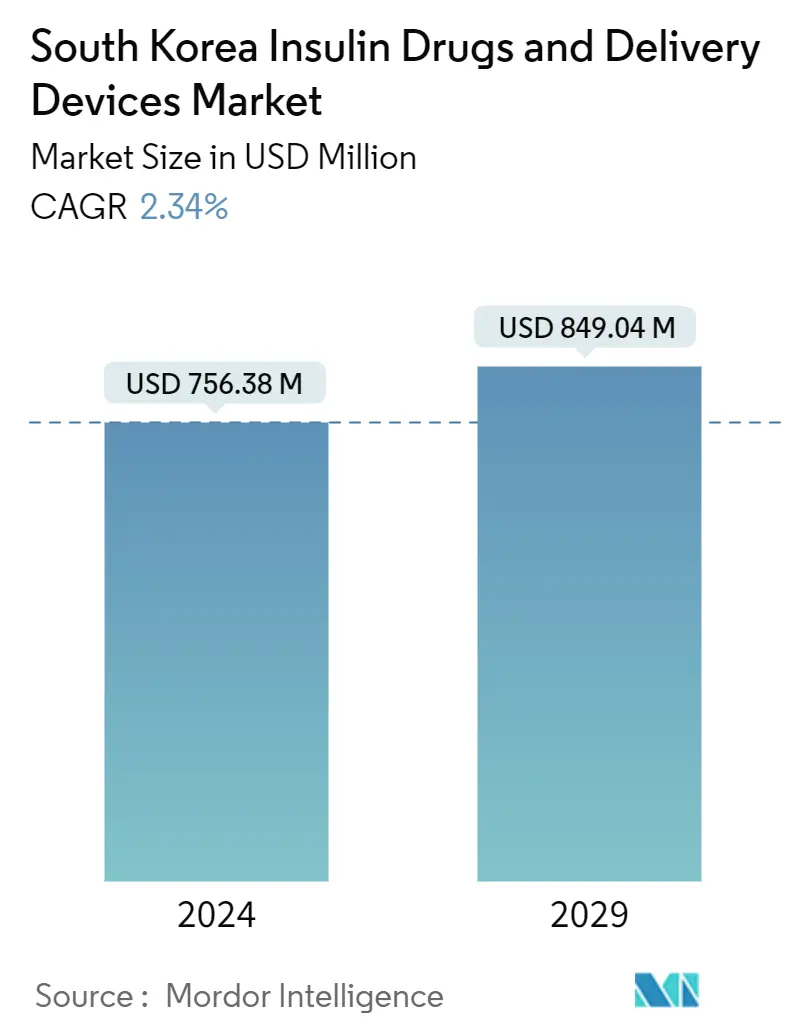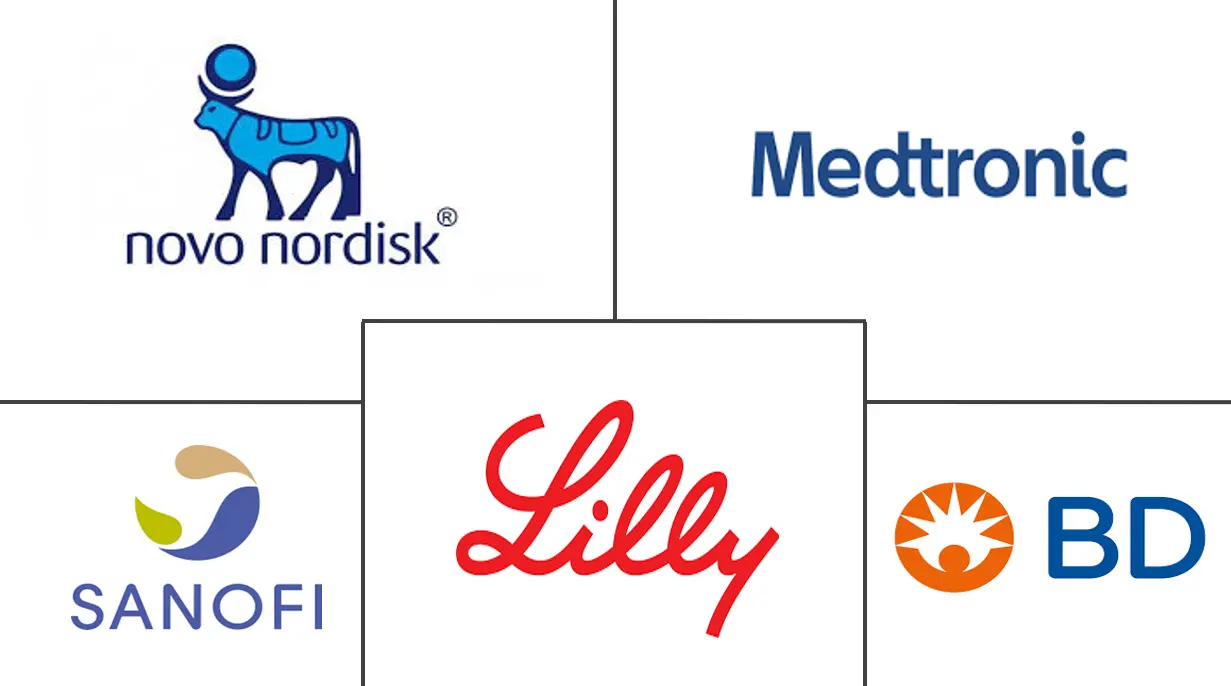Market Size of South Korea Insulin Drugs And Delivery Devices Industry

| Study Period | 2021- 2029 |
| Base Year For Estimation | 2023 |
| Forecast Data Period | 2024 - 2029 |
| Market Size (2024) | USD 756.38 Million |
| Market Size (2029) | USD 849.04 Million |
| CAGR (2024 - 2029) | 2.34 % |
Major Players
*Disclaimer: Major Players sorted in no particular order |
South Korea Insulin Drugs And Delivery Devices Market Analysis
The South Korea Insulin Drugs And Delivery Devices Market size is estimated at USD 756.38 million in 2024, and is expected to reach USD 849.04 million by 2029, growing at a CAGR of 2.34% during the forecast period (2024-2029).
One of the most significant risk factors for severe COVID-19 was diabetes mellitus. This risk is believed to be influenced by several variables frequently present in diabetes mellitus, such as advanced age, a proinflammatory and hypercoagulable condition, hyperglycemia, and underlying comorbidities (hypertension, cardiovascular disease, chronic kidney disease, and obesity). Diabetes was quickly recognized as a risk factor for bad results during the COVID-19 pandemic. That's why managing or delaying cases of type-2 diabetes became more important than ever before. Several studies have confirmed that chronic diseases like diabetes were associated with adverse outcomes in COVID-19 patients.
Diabetes mellitus is widely prevalent and imposes a substantial socioeconomic burden on individuals and society in terms of large medical costs. It leads to complications such as cardiovascular disease. These complications are associated with increased healthcare utilization, such as having more outpatient visits, a higher probability of being hospitalized, and increased use of more medications. Therefore, complications associated with diabetes drive the escalating costs of diabetes management and their financial burden on the healthcare system.
People with type-1 diabetes cannot produce adequate insulin because their immune system attacks their insulin-producing beta cells. In contrast, people with type-2 diabetes have insulin resistance and do not make enough insulin. Diabetes patients take insulin through an injection (syringe or pen), a pump, or inhaled form. In South Korea, the prevalence of diabetes in adults is higher, and the economic burden of diabetes is higher than that of overall cancer. It is expected that increased information regarding both the magnitude and the specific components of the economic burden of diabetes in Korea will influence health policymakers to prioritize its prevention and management and to allocate more healthcare resources to diabetes to boost the insulin market's growth.
South Korea Insulin Drugs And Delivery Devices Industry Segmentation
Insulin drugs are prescription drugs that contain insulin and treat diabetes mellitus using an insulin pump, smart pen, syringe, or other devices. The South Korea Insulin Drugs and Delivery Devices Market is segmented into Drugs (Basal or Long-acting Insulins, Bolus or Fast-acting Insulins, Traditional Human Insulins, Combination Insulins, and Biosimilar Insulins), Devices (Insulin Pens, Insulin Pumps, Insulin Syringes, and Jet Injectors). The report offers the value (in USD) and volume (in mL) for insulin drugs and (in units) for the devices for the above segments.
| Drug | |||||||
| |||||||
| |||||||
| |||||||
| |||||||
|
| Device | |||||
| |||||
| |||||
| Insulin Syringes | |||||
| Insulin Jet Injectors |
South Korea Insulin Drugs And Delivery Devices Market Size Summary
The South Korean insulin drugs and delivery devices market is poised for growth, driven by the increasing prevalence of diabetes and the associated socioeconomic burden. Diabetes mellitus, a significant risk factor for severe COVID-19 outcomes, has underscored the importance of effective management strategies. The market is influenced by the rising number of diabetes cases, particularly type-1 and type-2, which necessitate advanced insulin delivery methods. Technological innovations in insulin delivery systems, such as pumps and inhaled forms, are gaining traction due to their convenience and efficiency in maintaining blood glucose levels. The economic burden of diabetes, surpassing that of overall cancer, is prompting health policymakers to prioritize diabetes prevention and management, thereby boosting the insulin market's growth.
The market landscape is characterized by a few significant players, with leading manufacturers focusing on technological advancements to capture a larger market share. Insulin pumps, in particular, are expected to see substantial growth due to their advantages over traditional delivery methods, such as reduced blood glucose fluctuations and improved accuracy. Regulatory support from the Ministry of Food and Drug Safety, along with the National Health Insurance Act, facilitates market expansion by ensuring coverage and reimbursement for diabetes management devices. Recent mergers and acquisitions, such as Medtronic's acquisition of EOFlow, highlight the strategic moves by companies to enhance their market presence and address the evolving needs of diabetes patients in South Korea.
South Korea Insulin Drugs And Delivery Devices Market Size - Table of Contents
-
1. MARKET DYNAMICS
-
1.1 Market Overview
-
1.2 Market Drivers
-
1.3 Market Restraints
-
1.4 Porter's Five Forces Analysis
-
1.4.1 Bargaining Power of Suppliers
-
1.4.2 Bargaining Power of Consumers
-
1.4.3 Threat of New Entrants
-
1.4.4 Threat of Substitute Products and Services
-
1.4.5 Intensity of Competitive Rivalry
-
-
-
2. MARKET SEGMENTATION
-
2.1 Drug
-
2.1.1 Basal or Long-acting Insulins
-
2.1.1.1 Lantus (Insulin Glargine)
-
2.1.1.2 Levemir (Insulin Detemir)
-
2.1.1.3 Toujeo (Insulin Glargine)
-
2.1.1.4 Tresiba (Insulin Degludec)
-
2.1.1.5 Basaglar (Insulin Glargine)
-
-
2.1.2 Bolus or Fast-acting Insulins
-
2.1.2.1 NovoRapid/Novolog (Insulin aspart)
-
2.1.2.2 Humalog (Insulin lispro)
-
2.1.2.3 Apidra (Insulin glulisine)
-
2.1.2.4 FIASP (Insulin aspart)
-
2.1.2.5 Admelog (Insulin lispro Sanofi)
-
-
2.1.3 Traditional Human Insulins
-
2.1.3.1 Novolin/Mixtard/Actrapid/Insulatard
-
2.1.3.2 Humulin
-
2.1.3.3 Insuman
-
-
2.1.4 Combination Insulins
-
2.1.4.1 NovoMix (Biphasic Insulin aspart)
-
2.1.4.2 Ryzodeg (Insulin degludec and Insulin aspart)
-
2.1.4.3 Xultophy (Insulin degludec and Liraglutide)
-
2.1.4.4 Soliqua/Suliqua (Insulin glargine and Lixisenatide)
-
-
2.1.5 Biosimilar Insulins
-
2.1.5.1 Insulin Glargine Biosimilars
-
2.1.5.2 Human Insulin Biosimilars
-
-
-
2.2 Device
-
2.2.1 Insulin Pumps
-
2.2.1.1 Insulin Pump Devices
-
2.2.1.2 Insulin Pump Reservoirs
-
2.2.1.3 Insulin Infusion sets
-
-
2.2.2 Insulin Pens
-
2.2.2.1 Cartridges in reusable pens
-
2.2.2.2 Disposable insulin pens
-
-
2.2.3 Insulin Syringes
-
2.2.4 Insulin Jet Injectors
-
-
South Korea Insulin Drugs And Delivery Devices Market Size FAQs
How big is the South Korea Insulin Drugs And Delivery Devices Market?
The South Korea Insulin Drugs And Delivery Devices Market size is expected to reach USD 756.38 million in 2024 and grow at a CAGR of 2.34% to reach USD 849.04 million by 2029.
What is the current South Korea Insulin Drugs And Delivery Devices Market size?
In 2024, the South Korea Insulin Drugs And Delivery Devices Market size is expected to reach USD 756.38 million.

